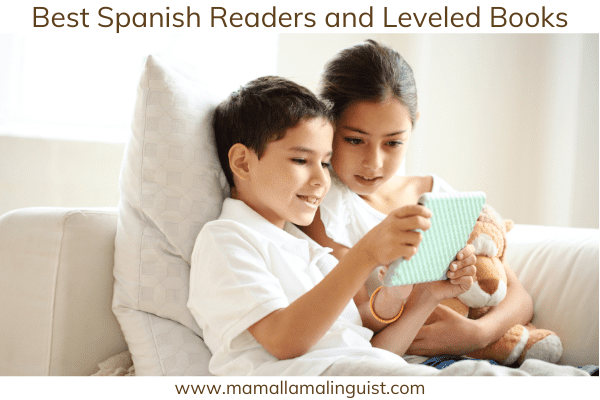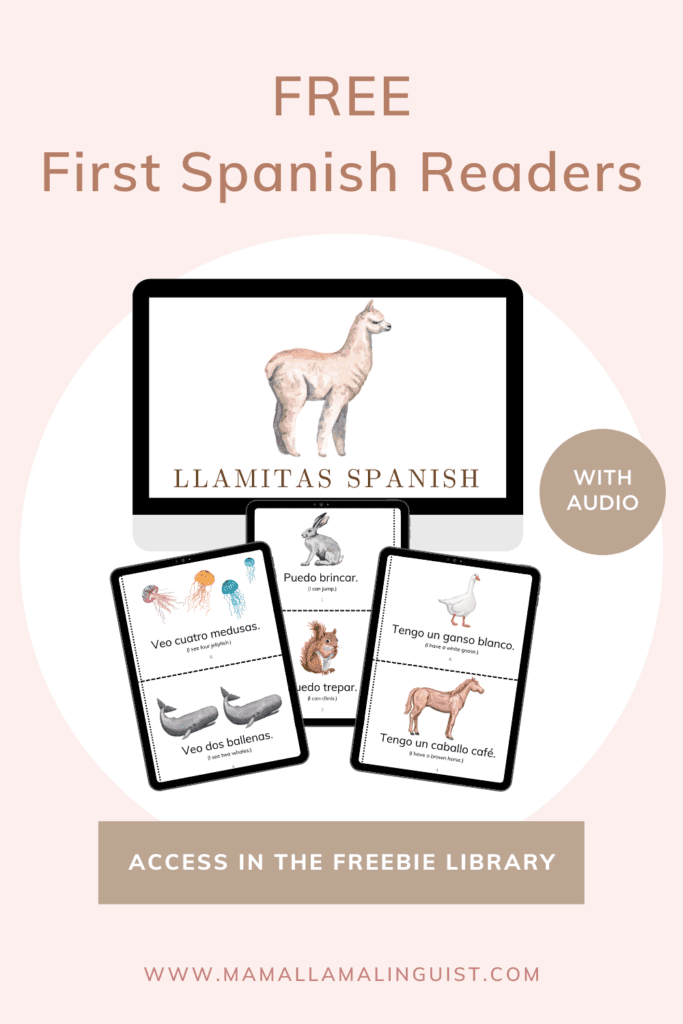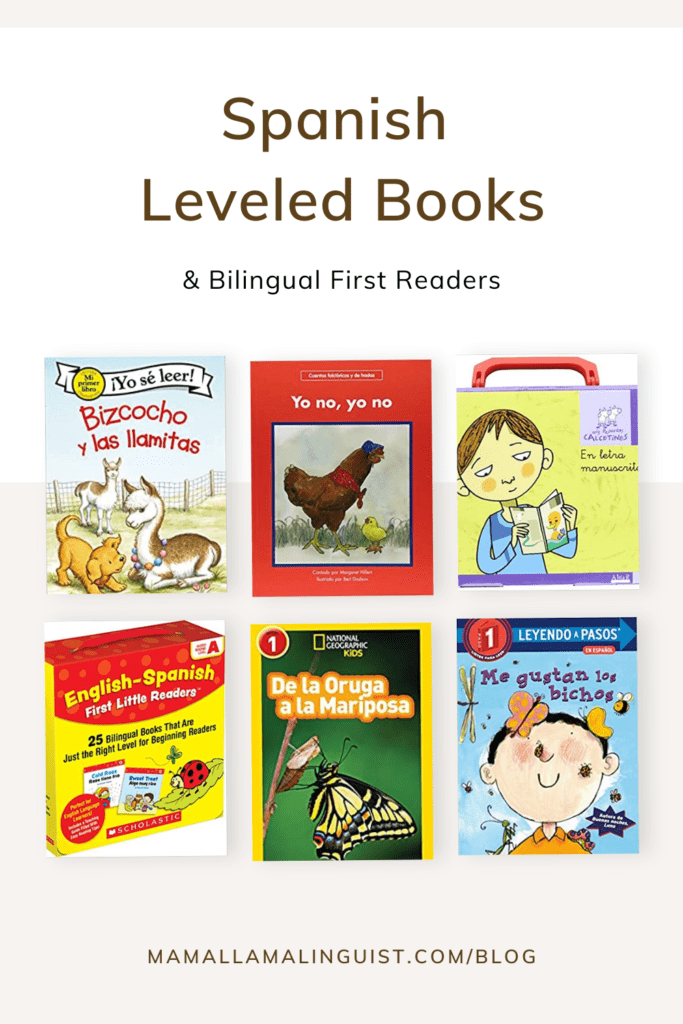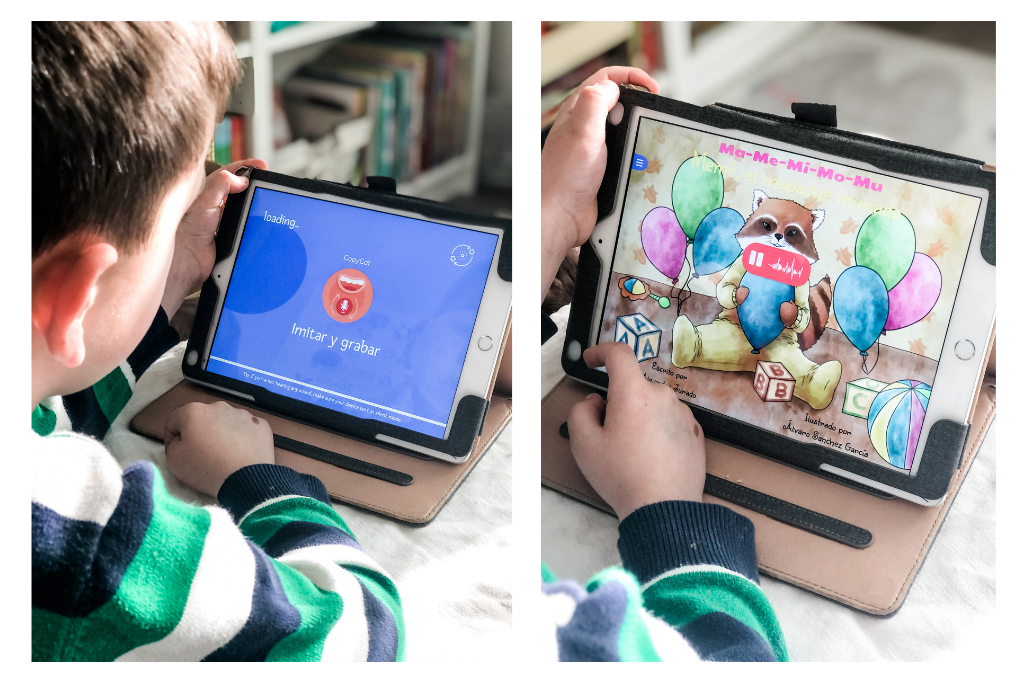In this post: Teach your kid to read in Spanish with these leveled books and first phonics readers. Plus get a FREE sample of our Llamitas Spanish First Readers with audio.
Do you want to support your child’s Spanish literacy skills and help them become confident and independent readers?
Leveled books and ‘First Readers’ are fantastic tools for building a child’s confidence and love for reading. Over the past few weeks I have reviewed dozens of leveled series in Spanish and I’m sharing our top picks.

This post contains affiliate links. As an Amazon Associate I earn from qualifying purchases.
Table of Contents
FREE Llamitas Spanish Readers
At Llamitas Spanish we nurture a love for literacy and the Spanish language through our beautiful thematic curriculum for ages 2-6.
Included in our curriculum are 24 beautifully illustrated Spanish First Readers. (Two for each of our 12 thematic units).
You can download a FREE sample with the first SIX in our Freebie Library to support your child with learning to read in Spanish.
Not confident with pronunciation? Don’t worry- you can listen to the native speaker audio narrations that are included.

Related post: How to Raise a Biliterate Kid
What are Spanish Leveled Books?
Leveled books support a child in learning to read and developing their literacy skills. Each book is designed to match a specific reading level and the level of difficulty slowly increases with each level.
Most importantly, they can help boost your child’s confidence and are designed to help your child make logical progress in phonetics and print awareness.
When Should you Start Teaching your Kid to Read?
The Preschool and Kindergarten years are described as the ‘critical window of opportunity’ for establishing literacy skills. This does not mean they are expected to read by then!
Most children start learning to read in Kindergarten, but this depends on many factors. Every child is unique and some are already able to read entering Kindergarten, while others have not even mastered letter recognition.
We must never force a child to read before they are ready. However, we can set the stage so they will want to learn to read and delight in engaging with books and stories.
At ages 0-2 we can begin the process of developing literacy skills by reading aloud often to our child and talking to them. Then at 3-4 we can begin gently introducing the alphabet and developing letter recognition through fun and interactive play.
Related Post: How to Teach your Child the Spanish Alphabet
More ‘formal’ reading can be started as soon as the child shows an interest. For my eldest, I read aloud every day to him but didn’t start leveled readers until he was 5 and wanted to learn to read. Whereas my mama tells me I was reading fluently before age 5. So it totally depends on the child!

Beginner Spanish Readers
The following Spanish Readers are fantastic options for beginner readers who are just starting to work on sight words and short 2-3 word sentences and each level gradually increases in difficulty.
English-Spanish First Little Readers
I did get all four (Levels A-D) of these bilingual reader sets and I have found them to be a perfect resource for both beginning readers and beginner Spanish learners.
Each book uses lots of repetition and the dual language text (English and Spanish) on each page really supports non-native speakers.
Each set is color coded (red L1, blue L2, green L3 and orange L4.)
By level 4 the books include past tenses and more complex sentence structures, but still just 2-3 sentences per page. A great option to really support your child in learning to read in Spanish.
My First Bilingual Little Readers
To my surprise, these readers are almost identical to the physical box sets above. The difference is that you have to fold and prepare them as they come as full pages.
Despite the cover showing color illustartions, the stories were actually in black and white which was a bit disappointing. However, I’m including this because it is so affordable!
If you can spare the time to prep them, this is one of the most inexpensive Spanish reader options.
It does not get more authentic than this! This collection of 24 original Spanish titles was first published in Spain. It is the only series I have found that is also available in cursive~ great for Montessori families!
This series would make a very special gift for a bilingual family.
Spanish for Kids: 10 First Reader Books with Online Audio
I love this little set of simple first readers in Spanish! The little mouse character is quite amusing and the stories are very well put together, with logical sequencing.
Topics include numbers, shapes, colors, food, clothes and many more.
Cuentos Foneticos de Scholastic
This Scholastic series is one I haven’t yet tried but was recommended to me. It’s definitely an older series, but a great option for beginner Spanish readers.
Related Post: How to Read in Spanish ~ 5 Tips for Beginners
Leveled Books in Spanish
There are many leveled books available in Spanish and I have enjoyed many with my 5 year old. Here are our top picks:
The Spanish language line of the popular Margaret Wise Brown guided reading series ‘Step into Reading’. Although not ‘authentically’ hispanic, these titles are affordable and cleverly sequenced.
There are 5 total series (or ‘pasos’) from Level 1: Preschool- K that focus on simple sentences, through Level 5 for 2nd-4th grade that are beginner chapter books.
Related Post: Best Spanish Chapter Books for Kids
Beginning-To-Read, Spanish Fairy Tales & Folklore
Although harder to find, these are our favorite Spanish readers, beautifully retold by Margaret Hillert.
We were able to purchase several of the bilingual versions and I just love the more classic illustrations.
Related Post: Latin American and Spanish Folktales for Kids
An adorable series about Rafi and his younger sister, Rosi, in Puerto Rico. Follow along as they discover the beauty of their country and all it has to offer. A fantastic series of adventure filled short stories for early readers!
Bizcocho (Mi primer libro ¡Yo sé leer!)
Biscuit in Spanish! These are some of my daughter’s favorite stories and now they are available in Spanish too.
In my opinion, these are more suitable for readers on their way to independent reading, as opposed to beginner books. They are less repetitive and have less high frequency words than other leveled readers.
The stories are still super engaging and perfect for classroom or at home read alouds.
National Geographic Readers in Spanish
A beautiful non-fiction series in Spanish by National Geographic Kids. These titles are for slightly older readers but I think the big illustrations will captivate younger children too.
From animals to volcanoes, rocks to weather, there are so many fun topics to enjoy in these short Spanish readers.
This is a really authentic and original Spanish series by Bambú written in Spain. There are plenty to choose from and I love that they are written by Spanish native speakers.
These are not at beginner level! They work great as first chapter books or newly independent readers.
Digital Spanish Readers
FabuLingua is a story-based language learning app that your child can enjoy independently. Beautiful interactive stories and fun games help your child learn to read and speak in Spanish!
We wrote a full review on the app and highly recommend it for ages 5+. It is a monthly subscription but you can try it FREE for 30 days!

Raz-Kids
This looks like a paid platform for schools, teachers and parents. It has a fantastic selection of 500+ Spanish Leveled Readers, many with audio, worksheets and comprehension quizzes. But to access most of the content you have to subscribe.
Don’t forget to grab your FREE Spanish Readers in our Freebie Library! Happy reading!
Related Content:
Spanish Preschool Morning Binder
Spanish Chapter Books for Kids
How to Teach your Kid the Spanish Alphabet
How to Read in Spanish: 5 Tips for Beginners
Founder of the Llamitas Spanish® Curriculum and former Spanish teacher. Corrie holds a Masters in Spanish and Education and is raising bilingual children in San Diego, CA.











